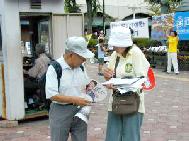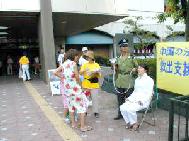(Clearwisdom.net) Nagano-ken is a typical Japanese region, where the mountains are beautiful, the water is clear and the people are kind and down to earth. After hearing that a Japanese man's wife, Yoko Kaneko, was unlawfully imprisoned by the Chinese government, many of the kind people in Nagano reached out a helping hand.
 Matsumoto Trolley Station |
| 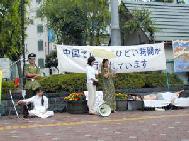 Yoko Kaneko speaking |
On August 7, 2004. traditional summer celebrations and fairs were held in different places in Nagano-ken. On this day, Yoko Kaneko went to Matsumoto, a city in mid-Nagano to express her gratitude towards the local people for their attention to her plight and for their efforts in rescuing her. Yoko also described to the public the persecution she personally experienced during her one and a half years of unlawful imprisonment in China. What distinguished this event from previous Falun Dafa activities was a live reenactment of torture methods used in China's labor camps against Falun Gong practitioners. People passing by stopped to watch. Constantly, people asked, "Are these kinds of tortures really happening in China?" In the end, Yoko said, "I hope that people here will continue to support those Falun Gong practitioners who are still imprisoned and tortured by the Jiang group in China, just as you have done to rescue me."
 Reenactments of forced-feeding, digging bamboo sticks into practitioners' fingernails, and confinement in an iron cage. |
| 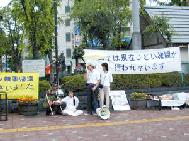 Introducing the torture methods used on practitioners in China |
Five methods of torture were reenacted: force-feeding, digging bamboo sticks into practitioners' fingernails, confined in a small iron cage, the "Police Bed," and the "Dead Person's Bed." Yoko especially introduced two methods of torture that she personally experienced: The "Dead Person's Bed" and the "Police Bed" (please see the photos). "Because I refused to give up my practice of Falun Gong, the jail guards tightly tied me on a 'Dead Person's Bed'," Yoko recounted, "The 'Dead Person's Bed' was made of a wooden board with five ropes on each side. They pressed me down to the bed. Then five strong men forcibly pulled the five ropes over my body until they could not go any further and fastened the ropes to the bed. They then pulled both of my hands backwards and shackled my hands on the bed legs. I was tied so tightly on the bed that I was unable to move. I was tied on the bed for more than 30 consecutive hours. Because I'm a Japanese citizen's wife, they were afraid of international attention if I was tortured to death. Therefore, they finally released me from the bed. At that point, I was already on the verge of death."
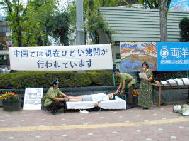 "Police Bed" |
|  "Dead Person's Bed" |
"Why is it called the 'Dead Person's Bed'?" Yoko continued, "Later, people told me that because the five ropes were tied so tightly, if the tying lasts for a relatively long time, it can cause blood vessels to break and internal bleeding to occur. Many people die after more than 10 hours of being tied on the bed. A number of Falun Gong practitioners were thus tortured to death on the 'Dead Person's Bed'."
When introducing the torture method called the "Police Bed," Yoko said, "The 'Police Bed' is an iron bed. They forcibly stretched out my arms and legs in four directions and then handcuffed my hands and shackled my feet to the four corners of the bed. My hands and legs were stretched to the point that I was unable to move at all. When they pulled my arms and legs, I heard a sound from my joints. It was very painful. They inserted a very thick tube from my nose into my stomach and used a syringe to force-feed me. Because the tube was too thick, each time, it was very difficult to insert it. In order for them to save the trouble, they simply left the tube in my stomach after the force-feeding. This way, since I was lying flat on the bed, the food they injected would flow backwards from the tube and spill onto my shoulder, chest and the bed. I was tied so tightly that I was unable to move. The guards would not help me clean up. In the hot summer, the rotten food smelled terribly and even the doctors and nurses were not willing to approach me. They put a catheter in my urethra and when I was menstruating, they simply put some tissues under my body. In this way, I was tied on the bed for more than 20 consecutive days. Except for force-feeding me, no one came close to me for those more than 20 days. When they released me from the bed, my entire body felt numb and was unable to move. The skin on my back was festering. After several days, my condition gradually improved."
In Nagano-ken, people live a peaceful and comfortable life. They could not imagine that such a brutal persecution is actually taking place every day in a neighboring big country. A Japanese person phoned me later and said, "Japanese people don't know much about this [the persecution of Falun Gong]. Please conduct more of these kinds of activities." Many people were appalled and could not believe that this was really happening in China. They asked again and again whether all of these tortures were really happening, and after they got an affirmative answer, they signed the petition calling for an end to the persecution.
|
|
|
|
|
|
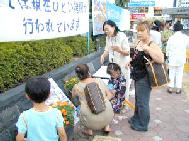 |
|  |
People learning the facts
A reporter asked Yoko, "Generally speaking, people who have experienced this kind of torture would not want to remember it. What do you feel when you recount this to people?"
Yoko answered, "Like other people, I don't want to recall this painful experience either. There were some other Falun Gong practitioners who were imprisoned with me in the same place. I am a Japanese man's wife. Simply because I wouldn't give up my practice of Falun Gong, they tortured me so badly that there were at least four times that I was on the verge of death. One could imagine how they would mistreat those Chinese Falun Gong practitioners who had no international connections. I am very fortunate. With the Japanese people's appealing on my behalf and the Japanese government's rescue efforts, I was able to come back to Japan alive. However, whenever I think about those countless Falun Gong practitioners who are still suffering from the persecution, my heart is bleeding. My conscience told me that I cannot keep silent. I hope that my experience will arouse more people's conscience, to help stop this persecution."
 Interview with a TV station |
|  A Chinese person comes to learn about Falun Gong |
After reading a flyer inserted in a morning newspaper, a Chinese woman drove half an hour to come over and learn about Falun Gong and the persecution. She said that she believed everything we were saying. Some of her family members were also arrested and imprisoned, and even sentenced to 7 years in prison because of their practice of Falun Gong. In the course of her conversation with practitioners, some misunderstandings she had about Dafa were cleared up. The woman left us her phone numbers and said she would contact us later.
We ask all kind-hearted people to stand up with us: "Please stop the persecution! Let the beauty of Falun Gong be spread to all people."
Background:
Japanese resident, Yoko Kaneko, 39 years old is from China. Her Chinese name is Luo Rong. She was born in Jixi City, Heilongjiang Province. In 1999, she was married to a Japanese man and currently lives in Niigata.
On May 24, 2002, when Yoko Kaneko was distributing Falun Gong truth-clarifying flyers on a street in Beijing, she was arrested by the police and was then imprisoned in a forced labor camp for one and a half years. During her imprisonment, her husband, family members and fellow Falun Gong practitioners worked together to rescue her. The Association for Rescuing Yoko Kaneko was established in Tokyo and an Internet Liaison of Citizens was also established in Osaka to collect petition signatures in Japan and from the Internet, and to conduct press conferences. The Association for Rescuing Yoko Kaneko held several SOS urgent rescue signature drives and walks in Niigata where Yoko resides.
On July 29, 21 Japanese Parliament members from four parties established the Multi-Party Coalition to Rescue Yoko Kaneko. Up to November 2003, the rescue campaign collected more than 160,000 signatures and received supportive letters from more than 270 officials, from Japanese Parliament members to council members of cities and villages.
Various governments, human rights organizations, groups and individuals from a number of countries throughout the world wrote to the Japanese government to call for the rescue of Yoko. Some directly wrote to the Chinese government to urge them to immediately release the innocent Falun Gong practitioners.
On different occasions, the Japanese government expressed that they would try their best to rescue Yoko Kaneko. For example, on November 18, 2003 when Yoko's term was up, Japanese Foreign Minister Yoshiko Kawaguchi expressed that the Japanese government would treat Yoko Kaneko as they would a Japanese citizen.
On November 27, 2003, under the strong call from all circles of the society, Yoko Kaneko successfully returned to Japan. During the 548 days and nights in police custody in China, Yoko had endured inhuman torture and she was on the verge of death on at least four occasions. Her hair turned completely white and she almost lost her eyesight. With her strong righteous thoughts, Yoko finally made it through all these tribulations.
After returning to a free society, Yoko did not forget those hundreds of thousands of Falun Gong practitioners who are still illegally imprisoned in China's labor camps. She continuously traveled around Japan and used her own experience to tell people about the viciousness and brutality of this persecution. She called upon people to work together to stop the persecution.
The torture methods exhibited were only a tiny part of what Yoko suffered in China.
Category: Rallies & Protests




